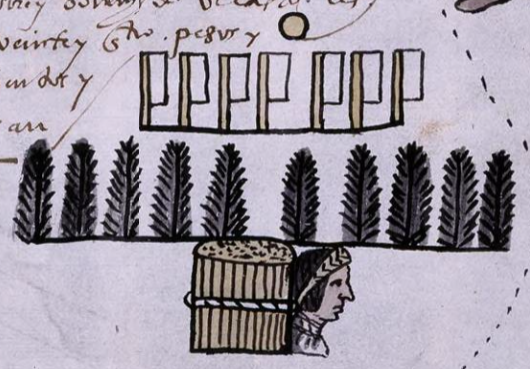tlamama (Osu10v)
This is an iconographic detail from the Codex Osuna, folio 10 verso (or image 23). It is included in this collection for the purpose of making comparisons with other loads, persons who carry things, and the technology that was employed for attaching a load onto a person’s back and head. In this case, a Nahua man with a standard haircut is shown from the shoulders upward, in profile, facing toward the viewer’s right. He wears a white shirt, and a woven tumpline crosses his forehead. A cord or rope also runs around the load the man carries. The load has vertical lines and dots at the top. According to the Spanish text on this page, the load comprises grasses (hierba in Spanish) that Nahuas gathered to provide to the colonizers so that they could feed their horses. The people who gathered and delivered some 4,141 loads of grass were expecting a large payment for this material, but at the time this manuscript was made, the payment had not been made.
Stephanie Wood
1551–1565
Jeff Haskett-Wood
cargas, cargar, hierba, forraje, pasto, comida para caballos, oficios, tameme, tamemes, tlamama, mecapal, mecapalli, mecapales, ixcuamama, tecnología, soga, mecate, mecates, cuerda, cuerdas, sogas, cordones, cordel, cordeles
tlamama, one who carries a load, https://nahuatl.wired-humanities.org/content/tlamama-0
el tameme, uno que lleva cosas
Stephanie Wood
Library of Congress Online Catalog and the World Digital Library, Osuna Codex, or Painting of the Governor, Mayors, and Rulers of Mexico (Pintura del Gobernador, Alcaldes y Regidores de México), https://www.loc.gov/resource/gdcwdl.wdl_07324/. The original is located in the Biblioteca Nacional de España.
"The Library of Congress is unaware of any copyright or other restrictions in the World Digital Library Collection. Absent any such restrictions, these materials are free to use and reuse." But please cite the Biblioteca Nacional de España and this Visual Lexicon of Aztec Hieroglyphs if you use any of these images here or refer to the content on this page, providing the URL.



